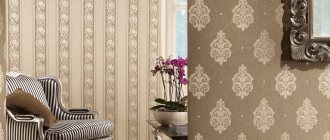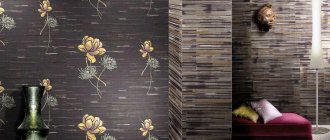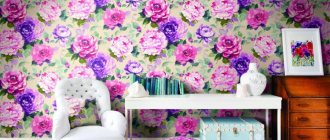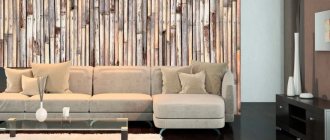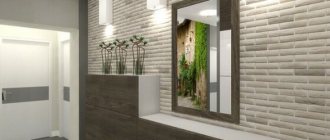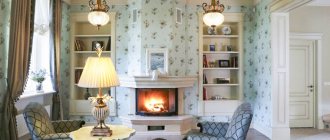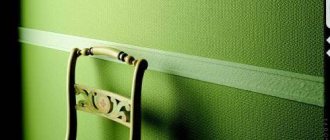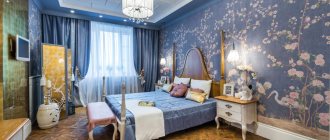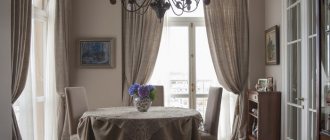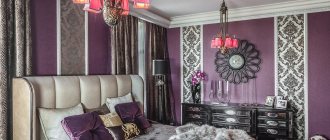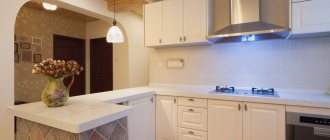Time passes, but wallpaper still remains a popular material for wall decoration. Including in the kitchen. Perhaps this is generally one of the simplest and most accessible ways for everyone to make the interior more beautiful, but you will make it many times more unique and interesting if you try to combine several shades and even textures in one room at once. The design of combined wallpaper in the kitchen in this regard seems to be a truly fertile territory where you can come up with really cool and non-trivial combinations.
The advantages of combined wallpaper
If you are trying to combine two types of wallpaper in the kitchen, then you are killing not two, but three birds with one stone:
- correct deficiencies in layout and texture - narrow or, conversely, expand the space, level out crooked walls or individual cosmetic defects;
- divide the common kitchen space into functional zones;
- you place the right color accents - this not only allows you to set the right mood, but also emphasize a specific element that plays a key role in your interior scenario.
We also note that you do not need any special tools to hang wallpaper. Just regular wallpaper glue, a stationery knife and a scraper to smooth out bubbles.
Why combine wallpaper in the kitchen: photos of stylish combinations
Several types of wallpaper are often used in the interior, creating stylish combinations. These may be different colors of wall coverings or different textures. It looks stylish and original.
Combining wallpaper allows you to eliminate the shortcomings of the room
Benefits of use:
- The ability to zone rooms into the main functional parts of the room;
- You can separate or connect the kitchen with adjacent rooms - a corridor or living room area;
- By combining wallpaper you can hide defects and unevenness of the wall;
- You can eliminate the shortcomings of the room;
- You can focus on certain architectural attributes.
Zoning the room allows you to properly distribute the area. Doing this with several types of wallpaper helps save space. Wall coverings do not take up much space, and a wide selection helps to create any style.
Basics of proper combination
- Wallpapers with the same level of density and approximately from the same price segment are combined. This way, all your joints and seams will look extremely neat, and the wear of the fabric will be approximately equal.
- Give preference to washable options. Do not forget that you are dealing with a kitchen that is actively used for its intended purpose, which means that drips and contamination are inevitable. In addition, such wallpaper will last you much longer, since it is not afraid of either high levels of humidity or direct contact with water.
- The design slogan “Everything goes together” works well in cases where there is a solid texture and the range of expressive tools used is not limited. Applicable to small kitchens up to 10 sq. m. It is still better to follow certain principles and combine wallpaper taking into account the overall design style.
- In order to correctly combine wallpaper in the kitchen, when choosing in a store, simply attach one canvas to another. It’s good if it is possible to make a conditional model of the interior on a computer. At many points of sale, this service is free and really helps with the choice.
How to wallpaper a kitchen with different wallpapers: photos of proper wallpapering
There are a number of rules according to which it is necessary to produce a combination of wall coverings. If you follow simple tips, the interior will turn out stylish and cozy.
Combination requirements:
- It is necessary to choose combined wallpapers of the same price policy;
- It is better to buy wallpaper of the same thickness to avoid problems with joints when gluing;
- The general appearance of the wall covering should be combined with the interior of the kitchen and correspond to its functionality;
- Different wallpapers should have something in common: ornament, color details, texture;
- Bright photo wallpaper covering the entire wall must be combined with a plain wall covering;
- Wallpaper with floral patterns is combined with wood motifs;
- When choosing abstraction, you need to take a closer look at wallpaper with geometric shapes;
- Bright colors should be combined with neutral pastel shades.
Article on the topic: Design of curtains: tiebacks, ties, pins - which is better
It is necessary to combine wallpapers of the same pricing policy and quality
All the requirements are quite logical. You need to create a harmonious design. Avoid cluttering the space with many patterns, colors, textures.
You need to calculate the number of rolls in advance and decide on the types of wallpaper.
A detailed plan needs to be created. It is necessary to determine which walls need a certain coating. In this case, it is better to buy wallpaper with a reserve.
Horizontal and vertical combination
If you live in a Khrushchev-era building and the size of your kitchen leaves much to be desired, then the best option is vertically combined wallpaper.
This combination will visually raise the ceiling and slightly expand the room. Of course, all this is a visual illusion, but what difference does it make if this makes the kitchen more comfortable?
Wallpapers can be combined:
- symmetrically - from the center in different directions, a simpler and more practical option, ideal for narrow kitchens;
- asymmetrical - strips of different widths are used and placed in different corners of the room, significantly enlivening the space.
If you have a larger kitchen, then it makes sense to combine the wallpaper horizontally. It is often practiced to divide a wall into top and bottom, and moldings and borders are used to decorate the transition.
Preparing the wall correctly
Work always begins with preparing the walls.
Step 1 . A high-quality result cannot be achieved unless you first remove the old wallpaper and putty the wall. All this is not difficult to do with your own hands.
To remove old wallpaper from the wall, use a metal spatula and a spray bottle (wet wallpaper is easier to remove from the wall). Old coatings - peeling paint and whitewash - also need to be removed.
Step 2 . After this, the walls must be leveled with putty. Vinyl and non-woven wallpaper can be used to cover surfaces with minor defects, but large irregularities, cracks, etc. must be eliminated.
Advice! Keep in mind that for non-woven wallpaper, one layer of putty will be enough, but for vinyl, and especially paper, a more even surface will be required.
Step 3. The last layer of putty must be sanded.
Step 4. Now you need a primer. After such operations, your old walls will be unrecognizable, and all coatings will be glued to them without difficulty.
To learn more about how to properly putty and level the walls yourself for wallpaper, watch the following video:
Popular combinations of two types of wallpaper
From theory to practice. Let's try to demonstrate with specific examples and photos how you can beautifully and, most importantly, harmoniously combine wallpaper with each other in the kitchen. We are looking for a variety of combinations - and revealing the secret of their successful use in the interior.
Combine the pattern with light green color
The decorative effect of the combination is enhanced significantly if the same color from the pair is used as the background for the image.
On one wall, a straight vertical combination was used.
A little more floristry. In the photo below, fresh flowers on the kitchen dining table, wallpaper with a floral motif and plain light green flowers are in perfect harmony with each other.
Abstraction + mustard color
In general, abstract compositions can be combined with any color and invariably obtain an ideal color balance, if they contain its elements.
Abstraction + flowers
It would seem that this is an oxymoron, but with balanced shades anything is possible. Harmony is guaranteed.
We combine photo wallpaper and brick texture
Combining different textures is always bold and interesting.
Photo wallpaper + yellow/gray color
Emphasize the importance of the dining area with beautiful photo wallpaper. A win-win that always works. Even with the yellow color, which is sometimes very capricious in relation to other shades.
Compared to the option above, the gray solution looks much more modest. But the tasks of organizing color temperature in a room are obviously different.
Combination of photo wallpaper and light green color
A light green shade will make even the smallest room cheerful, and the mood of the people in it - festive. Especially if you correctly combine it in the kitchen with a large-scale floral photo.
Geometry + light gray
Circles are also geometric shapes. And they go great with gray. Moreover, it echoes them and is present as a background.
Several other examples where the owners placed emphasis on the wall adjacent to the dining area.
Lilac color + neutral white
The wall adjacent to the dining area can be highlighted with plain, pale lilac wallpaper. As a pair - consonant shades. But you can also just neutral white.
Pattern and vertical stripes
The drawing can be anything. In this case, an imitation of a kitchen set. Vertical stripes also work great to expand the space upward.
You can do without drawing. Especially if the stripes are heterogeneous in color and perfectly enliven the interior. A great way to combine wallpaper in the kitchen if you don't want to delve into the nuances of color combinations.
Flowers and trees
Most often, an element with a pattern is placed in close proximity to the dining table. If the color on the background overlaps with the pair, the result is such a harmonious pair that sometimes it seems that these are not two types of wallpaper, but the same one.
Here is an example of the synthesis of yellow with a bright floral bouquet. It greatly refreshes the atmosphere, which is as important for a tiny kitchen as air is for a person.
Similar options in a more modest interior.
A risky option is a rich floral bouquet with dark gray or even as close to black as possible. The risk is due to the potential narrowing of space. But in the case, as in the photo below, it was possible to beautifully combine such wallpaper even in a very small kitchen.
Orange and yellow in one interior
You can beautifully beat this cheerful couple if you connect them not on a separate wall, but on a transitional niche. Cozy, bright and somehow homely.
Dark-light couples
Contrasting shades make the most effective combinations. They radically transform the interior design and saturate the space with energy. However, take a look for yourself.
Wallpaper to match the chosen design style
Clothing for the walls should harmoniously complement the chosen finishing and furnishing option, and a variety of wallpaper for the kitchen in Leroy Merlin and other specialized stores will help you find the most attractive design options.
- For a classic design, select an exquisite floral pattern or light stripes, photo wallpapers that imitate ancient frescoes.
- Provence is characterized by faded tones with natural patterns (flowers, leaves, butterflies).
- For country style, checkered designs, images of fruits, berries, vegetables, and imitation fabrics (matting or canvas) are suitable.
- In modern styles, preference is given to plain wallpaper.
Photos of wallpaper for the kitchen show the diversity of this design element and make it possible to choose the most suitable patterns and shades.
How to paste walls - step-by-step instructions
So, how to hang wallpaper correctly? The walls are already completely prepared - the old coatings were removed, and the surface was puttied and primed. After the primer has dried, we select options for applying glue (depending on the type of material used):
- In the case of paper-based vinyl wallpaper, the canvas is coated;
- To glue non-woven wallpaper, glue is applied to the walls.
It is recommended to apply wallpaper both to the wall and to the canvas - this ensures better adhesion of the surfaces, in addition, joining the pattern and aligning the canvases will be easier.
If you need to apply glue to the canvases and not to the wall, then prepare a clean place for them in advance.
The glue is applied in an even layer to the wallpaper without gaps, after which the canvases are folded in half and left for several minutes. Particular attention should be paid to the wall - in the place where the wallpaper will be joined (after all, modern materials are glued end-to-end, not overlapping). Work should begin from the center of the room if it has 2 windows or from the corner of the wall where the window opening is located.
The first canvas is glued just in the corner - so that it overlaps the adjacent wall by 5-6 cm. Before gluing the first canvas, be sure to mark a vertical line along a building plumb line or level - this line is drawn with a pencil along the wall, as shown in the photo above. Start gluing the wallpaper on top, aligning the canvas exactly along the vertical line. First, the top and edge of the material are exposed, and only a rag or brush is used for pressing, but not a roller. After the upper part of the canvas is glued, open the lower part and also carefully level it to the plinth.
After the canvas is aligned and fixed, it is pressed in a herringbone pattern, first in the center, and then to the side, moving from top to bottom.
If a micro-gap forms between the panels at the joints, they can be easily moved. It will be easier to do this if the canvas is coated with the wall. At the final stage, you need to additionally coat the joints and go over them with a short rubber roller to fix them.
Then follows the quality control of gluing - the wallpaper should fit tightly to the wall without air bubbles. After the entire room has been pasted over and the canvas has dried a little, you can trim off the excess that has formed at the top and bottom. Here it is important to use a sharp knife so that there are no burrs left at the cut site, or cut evenly with scissors at the bend, as shown in the next photo.
How to glue the last piece? Measure the width of the area of the wall that has not yet been pasted over and add 1.5 - 2 cm to it (photo 1). Cut the canvas to the desired width. Now join this fabric with the adjacent fabric, glue and iron the seam, and then in the corner vertically smooth the resulting overlap with a rag or brush (photo 2).
Carefully trim off the excess at the corner, top and bottom. Wipe off any remaining glue with a sponge. Keep in mind that the resulting pattern may not line up perfectly, but it won't be too noticeable in the corner.
